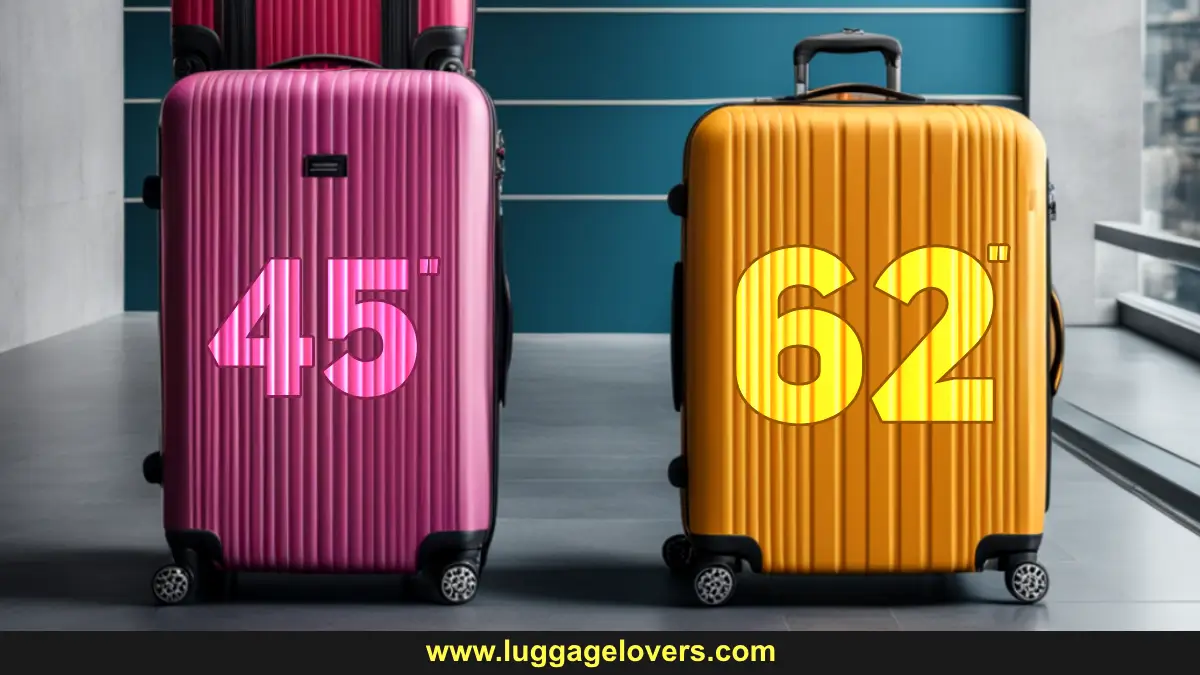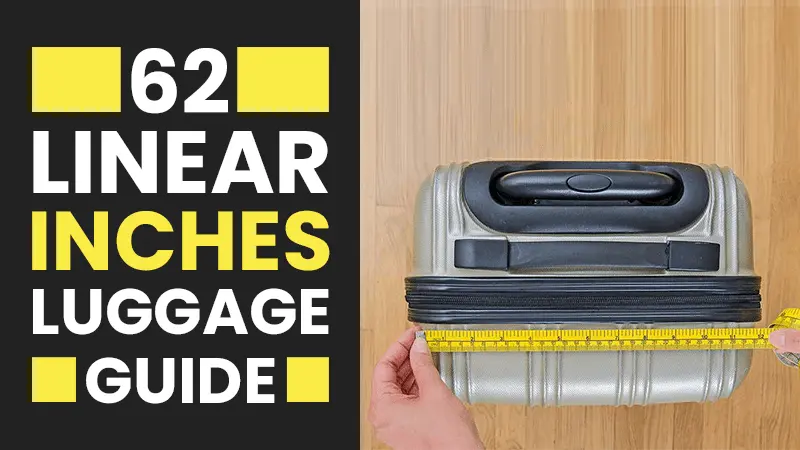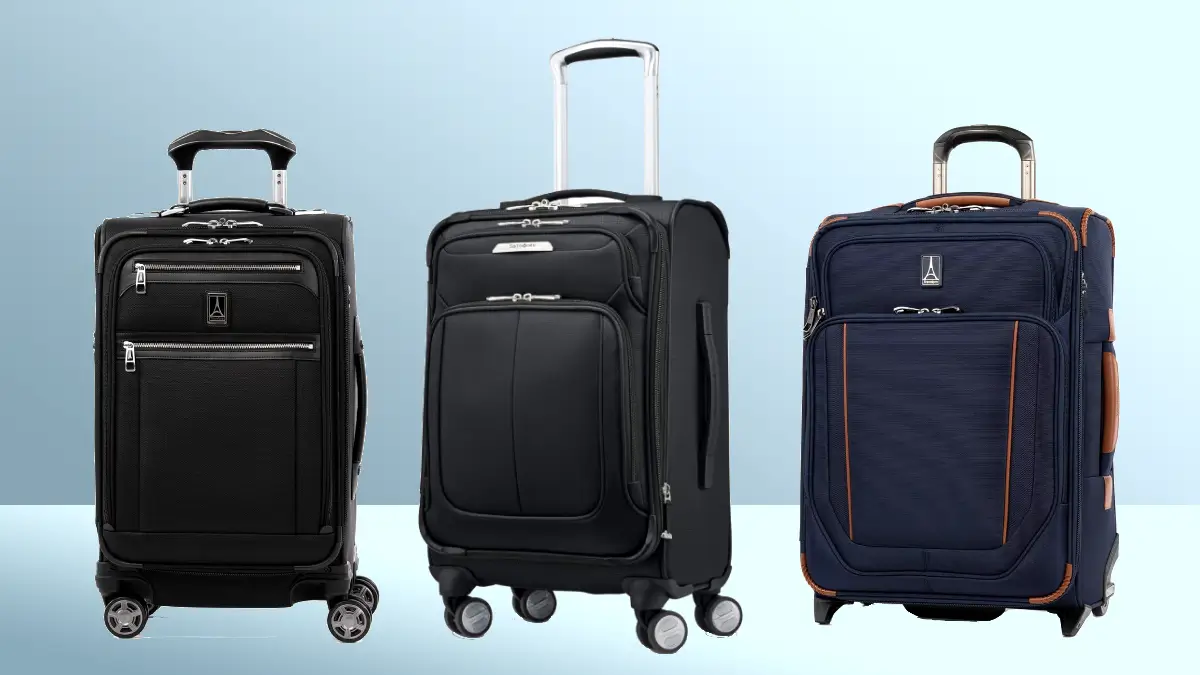Ultimate Guide to Luggage Size and Linear Inches Rule: Most FAQs Covered
Are you tired of the stress and confusion that you face when choosing the right luggage size for your travels? Don’t worry anymore; let’s welcome you to our guide to luggage size and linear inches, where we’ll cover all your burning questions about luggage sizes.
No matter whether you’re a seasoned traveler or a business traveler, we’ve covered the most frequently asked questions that people have in mind while traveling. We’ll also cover the airlines’ linear inch rules with luggage sizes so that you don’t exceed the airline guidelines and avoid paying extra fees for oversized luggage.
With our expert advice and insider knowledge, let’s start exploring the most frequently asked questions about luggage sizes.
Table of Contents
What are linear inches for luggage?
Linear inches are simply the sum of all the dimensions of a piece of luggage when it’s measured in a straight line. When the height, width, and depth in inches are added together, the result is called the linear inches.
Most airlines use this linear-inch rule as a standard measurement to ensure whether luggage or bags meet size restrictions. They follow this linear-inch rule mainly for checked luggage and a few airlines also use it for both carry-on and checked luggage.
That’s the reason why understanding the linear inches rule is essential for every traveler so that he can travel without stress and avoid paying additional fees for oversized bags.
What is the 62-linear-inch rule for luggage?
As we explained above about linear inches, 62 linear inches is also the most popular guideline that most airlines use for measuring checked luggage. 62 linear inches is the maximum allowed size for any checked luggage.
That means that the total or sum of the height, width, and depth of your luggage should be less than or equal to 62 inches. If any luggage exceeds 62 linear inches, it might be considered oversized luggage, and you might have to pay an additional fee for oversized luggage.
Let’s take an example for better understanding if your suitcase measures 28 inches in height. 18 inches in width and 16 in depth, the sum of all three dimensions would be 28 + 18 + 16 = 62 linear inches.
Make sure your luggage doesn’t cross these 62 linear inches. We’d also suggest you check the guidelines of the airlines you’re planning to fly with because these rules vary slightly from airline to airline.
What are the best 62 linear inches of luggage?
Finding the perfect luggage size is crucial among the hundreds of suitcases on the market. We’ve listed some of the best luggage that you can rely on. You won’t make a mistake, no matter which one you choose.
- Samsonite Freeform Hardside (Best Overall)
- Travelpro Maxlite 5 (Best Softside)
- Samsonite Omni PC Hardside (Most Popular)
- Delsey Paris Helium Aero Hardside
Things to Know about 28-Inch Luggage
Does a 28-inch suitcase meet 62 linear inches?
The answer is yes or no.
It depends; sometimes a 28-inch suitcase can meet the 62 linear inches guidelines and sometimes not. A suitcase of 28 inches in height alone doesn’t meet the 62 linear inches rule because it’s only one dimension.
To comply with 62 linear inches, you must sum up all three dimensions: height, width, and depth of your luggage and the sum of all three dimensions should not exceed 62 linear inches.
Let’s understand it with an example if your suitcase has a height of 28 inches, a width of 18 inches, and a depth of 16 inches, the total dimension would be 28 + 18 + 16 = 62 linear inches so it meets the 62 linear inches rule.
The most important thing to know here is that most luggage brands list their suitcases saying that it’s a 28-inch suitcase but in reality, it’s often around 30 inches, which ultimately exceeds the 62 linear inches and forces you to pay an additional fee for oversized luggage.
So don’t go on the written numbers; instead, check yourself to see whether the total of all three dimensions is below 62 linear inches or not.
Is 28-inch luggage too big for check-in?
As we explained above, the maximum allowed size for check-in luggage by most airlines is 62 linear inches. Generally, 28-inch luggage is not too big for check-in, so to ensure it meets 62 linear inches, add all three dimensions of your luggage and see if it’s below or equal to 62 inches or not.
But as mentioned above, a 28-inch suitcase does not necessarily mean it’s 28 inches; many times brands say it is 28 inches but in reality, it’s bigger and causes issues at the time of checking in.
Is 28-inch luggage considered oversized?
A 28-inch bag might sometimes be oversized and sometimes it might not be because it depends on the policies and guidelines of the airline you want to fly with.
A 28-inch suitcase is bigger than a carry-on and is considered checked luggage. For checked luggage, most airlines don’t have specific limits on the dimensions of checked luggage.
So no matter what the height, width, and depth of your luggage are, the overall linear inches of your luggage must be either below or equal to 62 inches. Mostly, a 28-inch suitcase is not oversized luggage but it’s recommended to measure your luggage properly before you leave.
Do airlines accept 28-inch luggage?
Yes, generally, airlines accept 28-inch luggage for checked baggage. Airlines are not concerned about the dimensions of any luggage; instead, they take care of whether the overall dimensions of luggage meet the 62 linear inches rule or not.
So if your luggage is 28 inches but the overall dimensions (the total of your luggage height, width, and depth) are above 62 linear inches, it’ll be considered oversized luggage and it’ll still be accepted by airlines, but you might have to pay extra charges for oversized luggage.
Things to Know about 45-Linear-Inches Luggage
What does 45 linear inches mean?
A 45-linear-inch size restriction is a standard used by airlines for carry-on luggage. 45 linear inches refers to the maximum sum of the height, width, and depth of carry-on luggage and it also includes handles, wheels, and any other protruding part of the luggage.
That means if a bag is below or equal to 45 linear inches, it’d be considered carry-on luggage by airlines.
But this rule is not a universal or most common rule for carry-on luggage; most, but not all, airlines measure carry-on bags or luggage in inches or centimeters. The most common restriction that most airlines follow for carry-ons is 22 x 14 x 9 inches. While the 45-line-inch rule is used by only a few airlines,
Some airlines, especially budget airlines, might have even stricter rules for carry-on luggage, so we’d highly recommend you check the rules of the airline you want to fly with.
What is the difference between 45 and 62 linear inches?
The main difference between 62 and 45 linear inches is that the 62 linear inches rule is mainly used for checked luggage, while the 45 linear inches rule is mainly used for carry-on luggage.
But let us tell you that, unlike the 62 linear inches rule, the 45 linear inches rule is not used by all airlines. A few airlines follow the 45 linear inches guidelines, while most have specific dimension restrictions, which are 22 x 14 x 9 inches.
This also means that a few airlines don’t have to do anything with the dimensions of your carry-on luggage, but the overall dimensions of your carry-on luggage should be less than or equal to 45 linear inches while for some airlines, your luggage height, width, and depth should be less than or equal to 22 inches, 14 inches and 9 inches respectively.
We’d highly suggest you check the policies and restrictions of the airline you want to fly with.
Is 45 linear inches a carry-on?
It depends on the airlines. Undoubtedly, the 45 linear inches rule is followed by a few airlines as the standard to measure carry-on luggage but exceptions are always there because a few airlines, especially budget airlines, have stricter rules, even as low as 40 or 42 linear inches.
So whether a 45-line-inch bag is a carry-on or not depends on the airline you prefer to fly with. But generally, for most airlines, 45 linear inches of luggage is a carry-on. If you have luggage that measures less than or equal to 45 linear inches, most likely it’ll be considered carry-on luggage.
But we’d highly suggest you check your airlines to avoid any hassle and ensure that your luggage qualifies as carry-on luggage.
Also Read: Why Choosing the Perfect Luggage Color Is Crucial
Is 46 linear inches a carry-on?
As we explained above, 45 linear inches is the standard followed by airlines. So if your luggage is 46 linear inches, as a general rule, it might not qualify as carry-on luggage.
However, there might be two conditions under which 46 linear inches of luggage can be considered carry-on luggage.
With a Few Exceptional Airlines
There are a few airlines that don’t follow the 45-line-inch rule; these are generally premium airlines that play loosely. They allow carry-ons to be up to 50 linear inches.
So if you’re traveling with such airlines, your 46 linear inches of luggage will be considered carry-on luggage but this does not apply to other budget airlines.
When an Airline Is Not Too Strict
Despite being bigger by one inch, your luggage is more likely to be recognized as carry-on luggage unless you meet a very strict inspection officer. But it’s not guaranteed; it depends on how strict an airline is with its regulations.
But it’s highly recommended to check out the policies and guidelines of your airline.
How big is a suitcase that is 45 linear inches?
For those airlines that follow specific dimensional restrictions, like 22 x 14 x 9 instead of 45 linear inches, your luggage must meet the guidelines for each dimension. But for those airlines that follow the 45-line-inch rule for carry-on luggage, you can play freely.
Because 45 linear inches is simply the sum of the height, width, and depth of your carry-on, including wheels and handles, you can use carry-on luggage with any dimensions as long as the sum of your carry-on is below or equal to 45 linear inches.
In this way, there can be various dimensions for 45 linear inches of luggage, such as:
- 22 x 14 x 9 Inches
- 20 x 16 x 9 Inches
- 23 x 13 x 9 Inches
These are just examples to make you understand and the actual dimension might differ.
The Final Thoughts: The Safest Size for Carry-On and Checked Luggage
If you don’t want to go into detail and still prefer to be safe from the restrictions of almost all airlines, you must meet the following guidelines, which we’ve explained below:
For carry-on luggage
The most common standard that almost all airlines follow is 22 x 14 x 9 inches, which means that the height of your luggage should not exceed 22 inches, the width 14 inches, and the depth of your luggage 9 inches.
If you follow this standard, you’re almost covered by all the airlines and don’t have to go into depth about the regulations. This is the safest guideline for carry-on luggage or bags.
For checked luggage
The most common and popular guideline that almost all airlines follow is the 62 linear inches rule, which means that the sum of the height, width, and depth of your luggage should not exceed 62 linear inches.
So measure all the dimensions of your checked luggage, add them together, and check if the total is below or equal to 62 inches or not. If it’s less than or equal to 62 inches, that means you’re covered by all the airlines. You don’t have to worry at all.
We’ve tried our best and we hope that this guide has helped you. If you still have any questions, let us know in the comment section below; we’d be more than happy to help you out.
Next Recommendation: What is the 62 Linear Inches Luggage Rule by Airlines?







